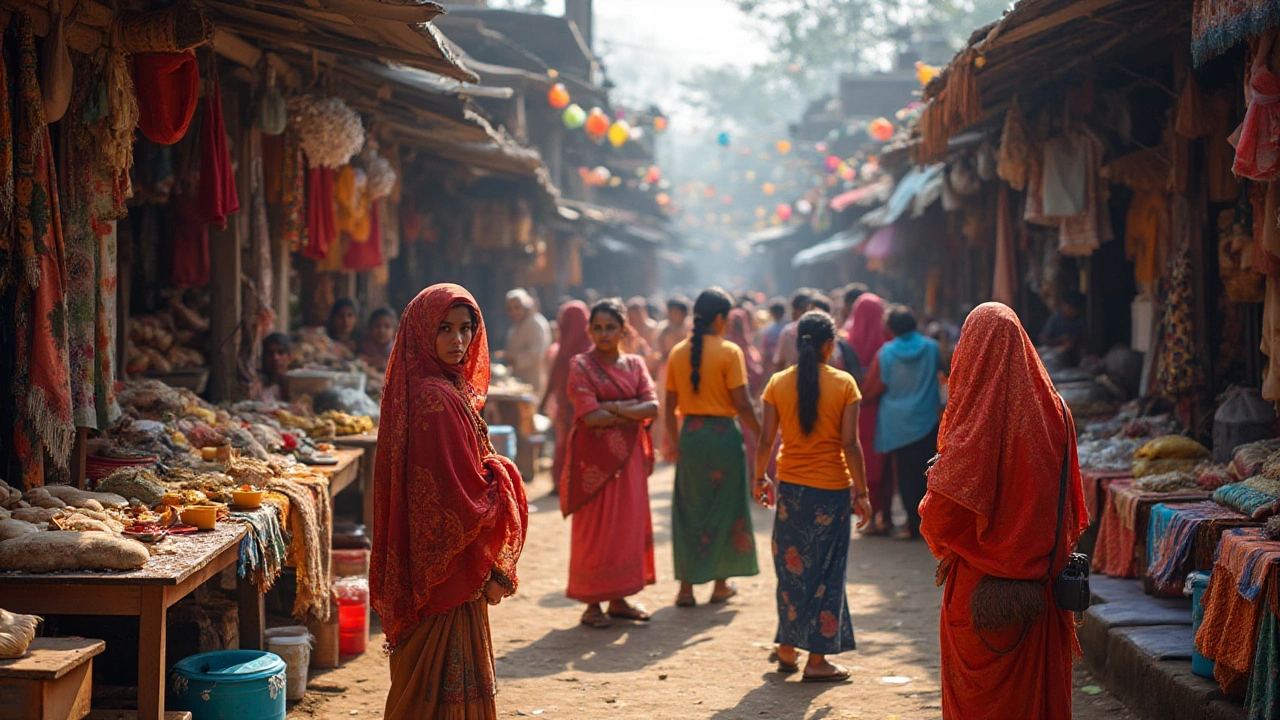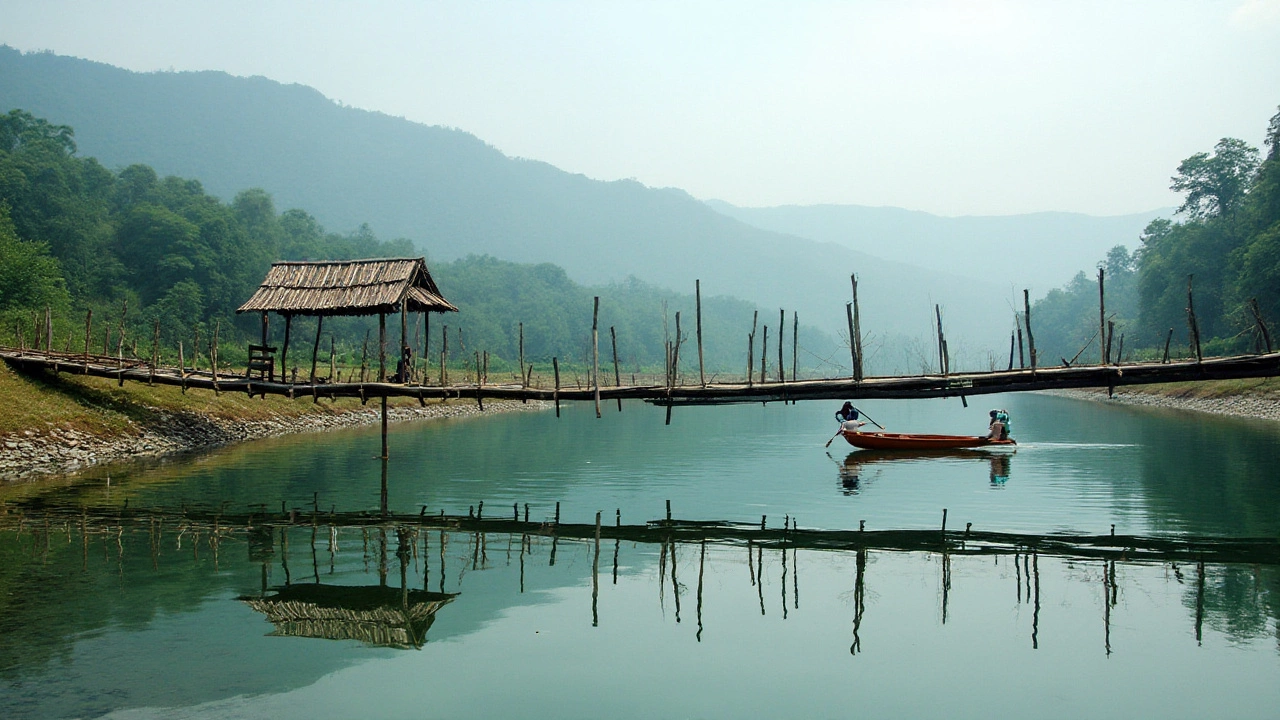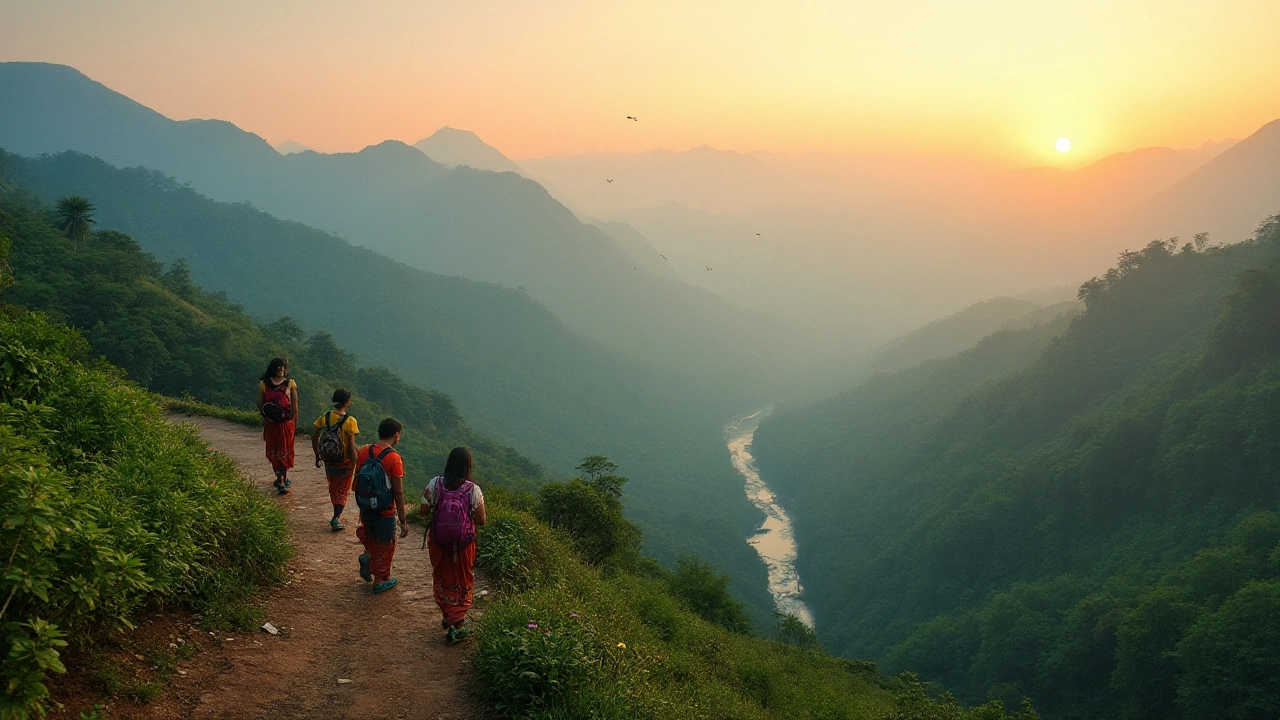Exploring Northeast India, an enchanting region brimming with hills, valleys, and cultural diversity, is a travel experience like no other. Travellers often wonder how many days are necessary to truly capture the essence of this region. With its blend of ethnic cuisines, scenic landscapes, and rich traditions, it's no wonder many feel drawn to this lesser-known corner of India.
From the lush green expanses of Meghalaya to the tribal festivals of Nagaland, each state offers a unique taste of life. Planning your itinerary requires a thoughtful approach, balancing between popular attractions and hidden gems. Whether you're a nature enthusiast, a culture lover, or an adventure seeker, understanding the appropriate length of stay can significantly enhance your experience.
By identifying must-see locations and local experiences, travelers can create a personalized journey that reveals the heart and soul of Northeast India. Dive into this guide to map out your ultimate travel adventure.
- Unique Features of Northeast India
- Ideal Itinerary for Northeast India
- Key Destinations and Attractions
- Cultural Experiences
- Travel Tips for Northeast India
- Best Time to Visit
Unique Features of Northeast India
Northeast India captivates travelers with its diverse cultural tapestry, unique tribes, and the bounty of nature. This remote yet vibrant region is composed of seven sister states: Arunachal Pradesh, Assam, Manipur, Meghalaya, Mizoram, Nagaland, and Tripura, each with its distinct identity and attractions. One of the most fascinating aspects is the rich biodiversity that stretches across the region's untouched landscapes. The Kaziranga National Park in Assam, known for its population of the majestic one-horned rhinoceros, is a UNESCO World Heritage site and a haven for wildlife enthusiasts. This lush sanctuary promises sightings of elephants, tigers, and migratory birds, making it a standout feature of the region.
Delving deeper, the cultural diversity is where Northeast India truly stands apart. With over 200 ethnic tribes, each boasting their own languages, customs, and traditions, visitors are offered a glimpse into a world of age-old rituals and colorful festivals. Nagaland’s Hornbill Festival, celebrated with fervor, showcases a symbiotic blend of cultural performances, crafts, and culinary arts.
The Guardian once remarked, "Northeast India is a land where every festival is a vibrant window into the rich cultural heritage of its tribes."Additionally, the landscapes are dotted with quaint villages, where bamboo houses rest on stilts amid lush tea gardens and serene lakes like Sikkim’s Lake Tsomgo.
Another striking feature of the region is its geographical marvels. Meghalaya, meaning ‘abode of clouds,’ is renowned for its living root bridges in Cherrapunji, formed by tree roots over decades. This engineering feat by the local Khasi tribe is a testament to sustainable living practices. The state also boasts some of the world’s wettest places, creating an ecosystem teeming with waterfalls and caves. Meanwhile, Arunachal Pradesh, often referred to as India’s wild east, offers breathtaking views of the Himalayas and unexplored trekking routes leading to serene monasteries. It is in these scenic spots that spirituality seamlessly blends with nature, offering a peaceful retreat.
Northeast India's cuisine leaves quite an impression with its array of flavors and unique cooking techniques. Influenced by its diverse tribes, the food here is distinct, with a penchant for fermented ingredients and robust spices, often featuring bamboo shoots, pork, and fish cooked in banana leaves. Such culinary diversity is best experienced through local street food tours or homestay experiences, which not only satisfy the taste buds but also introduce travelers to the warm hospitality of the locals. For those on their quest to explore the region’s unique features, a focus on the Northeast India travel dynamics, including the variety of experiences and sights it offers, makes the journey rewarding. These treasures are what make the region both intriguing and enchanting for visitors from all walks of life.
Ideal Itinerary for Northeast India
Embarking on a journey through Northeast India, travelers often wonder how to make the most of their visit without feeling rushed. Given the vastness of the region, a well-planned itinerary can help maximize the experience. The ideal duration to explore these enchanting lands typically ranges from two to three weeks, allowing time to absorb the rich culture and diverse landscapes each state offers.
An itinerary might begin in Assam, a gateway to the northeast, known for its lush tea gardens and the mighty Brahmaputra river. Guwahati, the bustling capital, serves as an excellent starting point. Spend a couple of days visiting the Kamakhya Temple and the Assam State Museum, immersing yourself in the region's history and spirituality. Don't miss a river cruise on the Brahmaputra, a serene escape that offers stunning sunset views.
From Assam, head east to explore the UNESCO World Heritage Site of Kaziranga National Park. Allocate at least two days for a safari adventure where you can spot the rare One-Horned Rhinoceros among other exotic wildlife. Post your wildlife rendezvous, a drive to the scenic hills of Meghalaya can be a refreshing change. Shillong, often called the 'Scotland of the East', offers cool climes and a vibrant music scene. Make sure to visit the picturesque Umiam Lake and the cascading Elephant Falls.
For a truly adventurous traveler, Meghalaya's living root bridges in Cherrapunjee are a sight to behold. Trekking through the lush green forests to these natural wonders is an experience not to be missed. Spending a few days here will let you explore Mawsynram, known as one of the wettest places on earth, adding an element of dramatic weather to your journey.
“Northeast India remains one of the most underrated travel destinations, with its myriad of cultures cradled in serene natural settings,” as noted by Lonely Planet.
As you return to Assam, consider a detour to the monasteries of Arunachal Pradesh, namely Tawang Monastery, which is deeply rooted in Buddhist traditions and offers breathtaking mountain views. Specific cultural festivals like the Ziro Festival of Music in Ziro Valley are scheduled in this period, providing a healthy dose of regional tunes and tribal artistry.
A visit to the northeast remains incomplete without experiencing Nagaland, especially during the Hornbill Festival. Celebrated in December, this festival showcases the rich Naga heritage through dance, music, and local crafts. Visiting during 6to8 December allows travelers to truly engage with local customs and traditions. Traveling across Northeast India with such a detailed itinerary ensures that visitors receive a holistic experience, mingling with nature while delving into centuries-old cultures. With carefully planned stops and adequate time, you can experience the wonders of Northeast India in all its fullness.

Key Destinations and Attractions
Embarking on a journey through Northeast India opens up a world of breathtaking landscapes and cultural wonders. This part of the country, often referred to as the 'Seven Sister States,' offers a variety of destinations, each with its own charm and allure. One prominent spot to begin your adventure could be the majestic Kaziranga National Park in Assam. Famous for its population of one-horned rhinoceroses, this UNESCO World Heritage Site is a sanctuary for countless species and an absolute must-visit for wildlife enthusiasts. Imagine starting your morning with a safari, eyes peeled for tigers, swamp deer, and elephants; it's a thrilling experience unlike any other. The park's lush grasslands and serene water bodies create a picturesque setting that draws in both photographers and nature lovers alike.
"Kaziranga is not just a national park, but a stunning saga of India's natural heritage," said environmentalist Bittu Sahgal.
Next on the list is Meghalaya's living root bridges, which offer a fascinating glimpse into the ingenious use of nature by the Khasi and Jaintia tribes. Tucked away in the dense rainforests, the village of Nongriat showcases these unique structures, woven from the roots of ancient trees. Walking over these bridges was once considered an ambitious trek, but today it seamlessly blends adventure with history. The sight of these bridges, covered in moss and vibrant foliage, makes for a surreal experience. Don't forget your camera, as every angle offers a new perspective on the harmony between humans and nature.
Venturing to Nagaland, the Hornbill Festival is an explosion of colors, dances, and traditional performances. Held every December, it celebrates the state's rich tribal cultures and serves as a platform for showcasing traditional music, dances, and crafts. Visitors can immerse themselves in the local customs and perhaps even partake in some traditional games. This festival brings together the diverse tribes of the region, offering a remarkable insight into the cultural fabric of Nagaland. For those planning their trip in December, this festival is an unmissable highlight.
The scenic beauty of Arunachal Pradesh, particularly Tawang, offers another splendid stop on your itinerary. The Tawang Monastery, nestled in the foothills of the Himalayas, invites visitors with its spiritual aura and stunning views. It's an incredible site for reflecting on the peace that the mountains bring, observing monks in prayer, and participating in the serene ambiance. The monastery is not only a spiritual hub but also a historical landmark, having been established in the 17th century. Here, one can spend hours soaking in the tranquil atmosphere while glimpsing the everyday life of devoted monks.
These destinations only scratch the surface of what Northeast India holds. As you travel through Manipur, Tripura, and Mizoram, each state unveils its own secrets, from verdant landscapes to vibrant cultural practices. Take time to explore local cuisines, discover handmade crafts in cottage industries, and engage with locals. When traveling to this remarkable part of the world, the key lies in remaining open to unexpected discoveries and embracing the quiet moments of awe that this region offers so abundantly.
Cultural Experiences
The vibrant tapestry of Northeast India travel comes alive through its myriad of cultural experiences, each providing a window into the region's soul. Known for its ethnically diverse population, this part of the world is home to over 200 tribes, each with unique traditions, languages, and festivals that have been passed down through generations. A visit here is akin to stepping into a living museum, where the customs of yesteryears coexist harmoniously with modernity. Travelers can immerse themselves in the pulsating rhythms of the Hornbill Festival in Nagaland, a grand celebration that showcases the music, dance, and crafts of the Naga tribes. This colorful spectacle is a must-see for anyone keen on diving deep into the cultural roots of the region.
The serene state of Meghalaya, often called the "Abode of Clouds," invites visitors to witness the Khasi culture. One can partake in age-old rituals such as the Nongkrem Dance, an exquisite thanksgiving dance performed by the Khasi community, accompanied by the deep notes of traditional instruments. Delving into these cultures, tourists have the opportunity to learn about the matrilineal society of the Khasis, where lineage and inheritance are traced through women, offering a unique perspective within the broader Indian social structure. Exploring local markets, like the Bara Bazaar in Shillong, offers not just a shopping experience but a chance to see the confluence of traditions in daily life.
Engaging with local communities often reveals stories and legends that have shaped the cultural landscape of Northeast India. The people of Assam, for instance, are proud of their centuries-old tea culture, with tea gardens sprawling across tranquil landscapes, producing some of the world's finest teas. Visiting these plantations, travelers can savor Assam tea while learning about the tea production process that combines traditional methods with new agricultural practices. A stop at a village in Assam might just find you partaking in Bihu, the Assamese festival that celebrates the changing seasons with spirited dances and songs.
"The cultural diversity of Northeast India is its true essence, offering a glimpse into the world of tradition and modernity," says renowned cultural historian Dr. Meera Kaul. "Travelers who engage with local traditions leave with more than just memories—they take home stories that last a lifetime."
For those looking to delve even deeper, a visit to Arunachal Pradesh, bordered by the snowy peaks of the Himalayas, reveals a beautiful array of tribal cultures and practices. Discover the spirit of the Monpa people through their festivals such as Losar, which marks the Tibetan New Year with vibrant processions and communal feasts. These celebrations are not only testament to the resilience and adaptability of these communities but also provide opportunities for cultural exchange and understanding. The welcoming nature of the people often leaves an indelible impression, making cultural engagement a cornerstone of travel in this enchanting region.

Travel Tips for Northeast India
When planning your journey through Northeast India, considering practical travel tips can enhance your experience. The region, though breathtaking, presents its own set of challenges due to its remote locations and diverse climates. To commence, travelers should focus on weather conditions. Northeast India is known for heavy monsoon rains, which can cause disruptions in travel plans. Always check the weather forecast for each state on your itinerary, ensuring your journey is safe and pleasant. Pack suitable clothing, such as lightweight raincoats and moisture-wicking fabrics, especially if you're planning to trek or explore the lush natural parks.
Another essential aspect is understanding local transport. Public transport in this part of India might not be as developed as in urban centers, but shared taxis and buses offer a unique opportunity to interact with locals. Opt for rented vehicles only when traversing steep terrains not covered by regular transport routes. While the roads can be unpredictable with serpentine paths and limited signposts, hiring a local guide can be a valuable investment. They not only provide navigation assistance but share rich stories and insights into the region’s history and culture.
The region demands travel permits, a process often overlooked by first-time travelers. Inner Line Permits (ILPs) are mandatory for certain states like Arunachal Pradesh, Nagaland, and Mizoram. Acquiring these permits in advance, either through online applications or with help from tour operators, will save time and potential hassles upon arrival. Always carry multiple copies of identification documents as checkpoints are common across state borders.
Northeast India hosts myriad ethnic groups, each with their own distinct customs and norms. Coexisting respectfully with local communities is crucial. Learning a few words in the local dialect can go a long way in bridging cultural gaps, bringing smiles to faces, and enhancing your travel narrative. Engage in conversations, respect traditional practices, and abstain from photographing individuals without permission—it demonstrates respect and encourages mutual understanding.
“Travel is more than the seeing of sights; it is a change that goes on, deep and permanent, in the ideas of living.” — Miriam Beard
Additionally, staying connected could be challenging given the region's topography. While major towns and cities like Guwahati and Shillong have reliable internet services, rural areas have limited connectivity. Download offline maps, keep a physical compass, and ensure your phone is equipped with a local SIM card if you rely on mobile guidance. Always inform family or friends about your travel plans and expected time of internet blackout to keep everyone at ease.
Naturally, food is an integral part of any travel experience. The cuisine in Northeast India is unique, often featuring bamboo shoots, fresh herbs, and traditional recipes passed through generations. Venture beyond standard eateries and explore local markets where indigenous tribes sell regional delicacies. Don’t miss out on sampling varieties of momos, savory thukpas, and the renowned Naga chillies for adventurous palates. Remember, trying local foods not only enriches your cultural experience but also supports local communities.
Best Time to Visit
Finding the ideal time to explore Northeast India can enhance your experience tremendously. This part of India is known for its distinct seasons, and each offers its own unique spectacles for travelers. The region typically experiences heavy rainfall from June to September, marking the monsoon period. During this time, the landscapes flourish with emerald green hues, but heavy rains may disrupt travel plans. Nevertheless, it's a breathtaking time to witness the copious waterfalls and lush tea gardens, provided you don't mind getting a little wet. From October to April, Northeast India enjoys a pleasant climate, which many consider the most suitable period for travel.
October brings a gentle coolness, a reprieve after the heavy rains, making the landscapes accessible again without the hassle of monsoon-induced disruptions. As you travel through states like Meghalaya, Assam, or Nagaland, the vibrancy of autumn colors and cultural festivals such as the famous Hornbill Festival in Nagaland present an immersive cultural tableau. Winter months from December to February are cooler, with temperatures varying according to altitude and proximity to the Himalayas. While states like Assam encounter amicable warmth, Sikkim may greet you with snow-capped vistas.
March and April are marked by spring, signaling a reawakening of the flora. Rhododendrons cover the hillsides in majestic splendor, making trekking an attractive pursuit during this time. Importantly, planning your travel around festival dates is not only an immersive experience but brings you closer to the heart of local cultures. Festivals such as Bihu in Assam or the Ziro Music Festival in Arunachal Pradesh showcase the diverse human tapestry and spirited lifestyles of the region. As described in Lonely Planet, "Northeast India, with its uncharted landscapes and ancient rituals, offers a journey like no other."
“Visiting the hills during cultural festivals reveals the warm hospitality and flourishing traditions embedded within the fabric of Northeast India." – Lonely Planet
To ensure a fulfilling trip, consider factors such as weather forecasts, local festivities, and personal preferences. Aligning your visit with the region's unique climatic and cultural characteristics will help you unlock the profound natural beauty and rich traditions that make Northeast India such a cherished destination.
